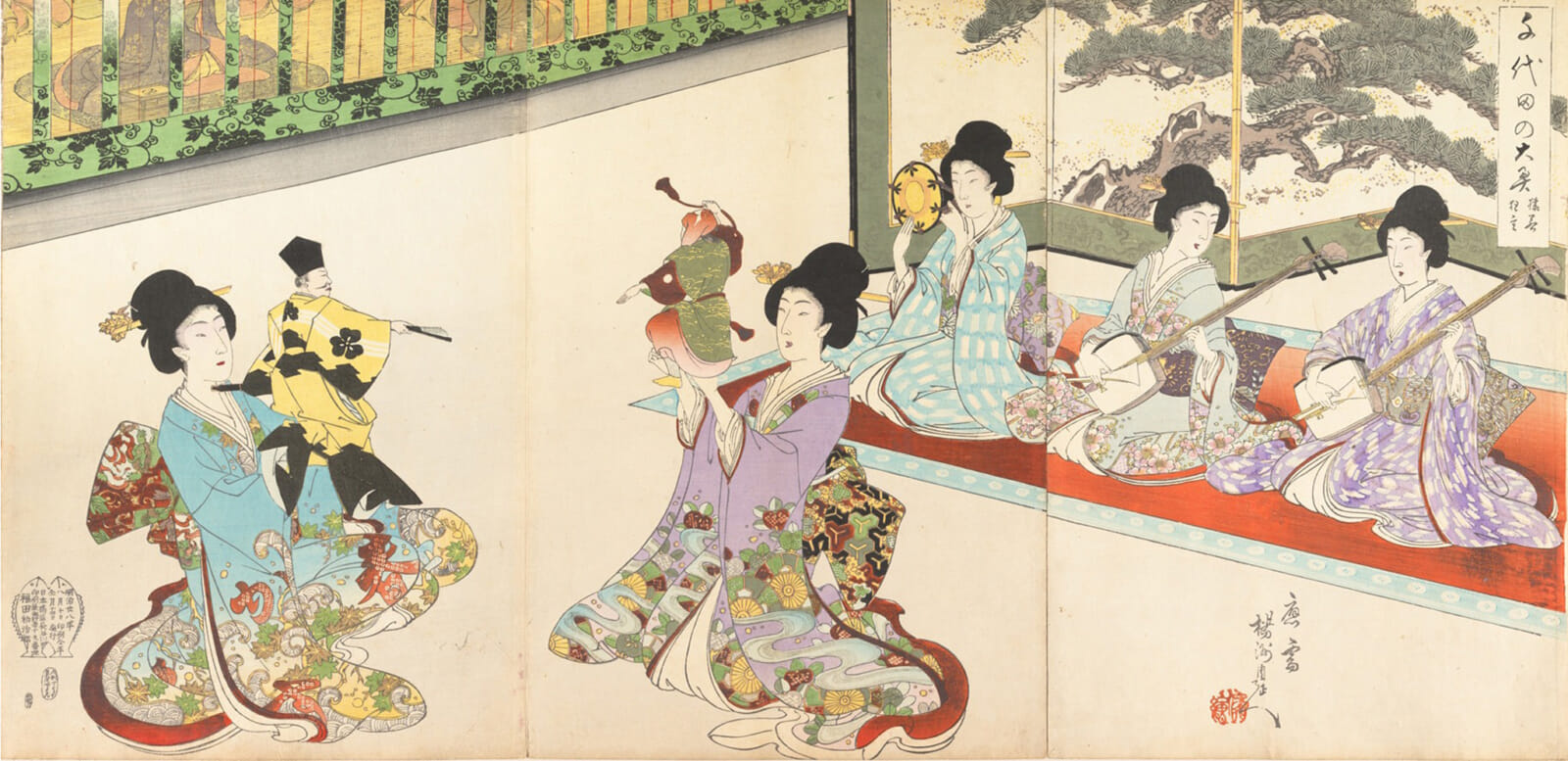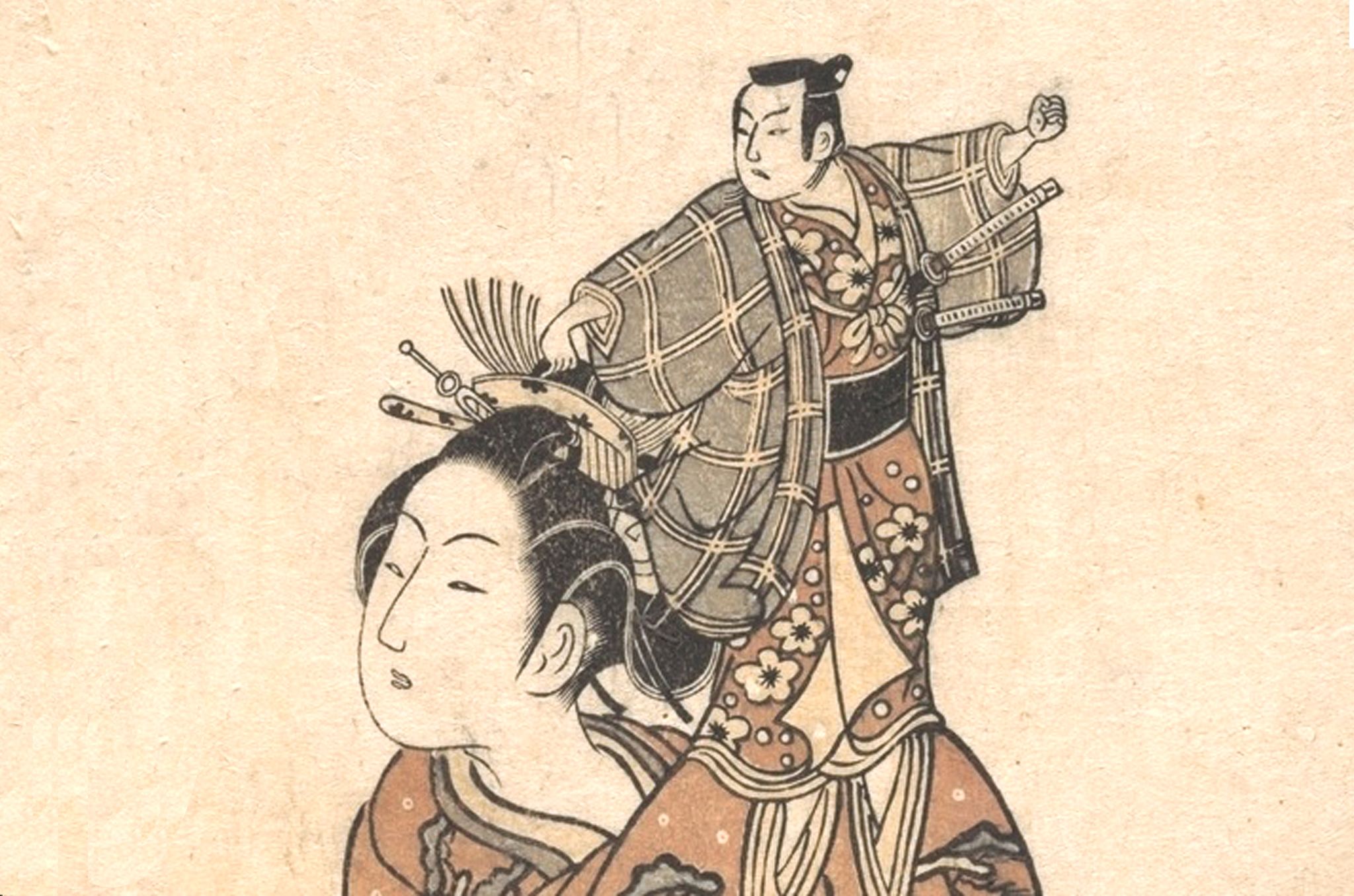Prostitution in feudal Japan was a very competitive business. Some professionals like the asobi made themselves stand out by operating on rivers and singing folk songs, though they weren’t the only ones. There were also the kugutsu who similarly combined singing and prostitution. Their entertainment portfolio, however, was much more diversified.
As a result, whenever some new social movement arose against working women, the kugutsu could still perform circus tricks and put on puppet plays. Or they just packed up and left, continuously moving across the country in traveling communities the likes of which Japan hasn’t seen before or since. So, who exactly were these Japanese nomads?

Toyohara Chikanobu “Ladies in Waiting of the Chiyoda Castle: Sword Practice and Puppet Kyogen,” 1895. Metropolitan Museum of Art
We Have No Idea Where the Kugutsu Came From
Some of the earliest accounts of the kugutsu — sometimes referred to as kairaishi — come from around the 8th century. Nobody is quite sure how they came to be, though. Japan wanted its citizens to stay put for census and tax purposes. While mandatory registrations at temples and shrines and permits for leaving your own village came later, the idea of not staying in one place (for non-monks at least) was considered bizarre when the kugutsu first appeared in historical records.
Since they fished, hunted and traded rather than cultivated fields, some have suggested that they were originally farmers who didn’t want to tend the soil. A more radical theory says that they may have been actual Romani people who traveled to Japan over a millennium ago.
That one is primarily based on the kugutsu’s Romani-esque make-up described in an essay by the imperial scholar Oe no Masafusa: “The women paint narrow curved eyebrows on their faces [and] use powder to make false teardrops on their cheeks.”
A more probable theory says that the kugutsu could have been immigrants from China or Korea since the nomads were best known for their puppetry and the old-Korean word for “puppet” is “kuktu,” which today survives as “kkogdugagsi.”
The Kugutsu Might Have Helped Create All of Japanese Theater
Masafusa also wrote that the kugutsu could “make wooden puppets leap and bound, and stage wrestling competitions between dolls made of peachwood.” The travelers’ association with puppet shows eventually overwrote their reputation for prostitution, and today, “kugutsu” simply means “puppet” in Japanese.
As their performances became more complex and accompanied by music, they slowly evolved into the “Ebisu Dance” doll shows that contributed greatly to the later development of bunraku puppet theater.
Even those kugutsu who didn’t do puppetry left their mark on Japanese theater. Masafusa wrote that the kugutsu could “twirl pairs of swords, juggle as many as seven balls … transform sand and pebbles into gold coins, and change grass and twigs into birds and animals.”
This description sounds an awful lot like sangaku, an umbrella term for various performing arts including juggling, magic and acrobatics, which arrived in Japan from China around the 8th century. Once it won the favor of royalty and court nobles, it evolved into sarugaku — a form of comedic dance-theater — around the 11th century.
In Shadows of Transgression: Heian and Kamakura Constructions of Prostitution, Janet R. Goodwin writes that the kugutsu “entertained at the emperor’s palace,” meaning that they very well could be the ancestors of sarugaku.
This is actually a big deal since sarugaku was the precursor of modern Japanese theater such as Noh and Kyogen. Kabuki theater has a separate history, but seeing as it’s closely linked to prostitutes, maybe the kugutsu had a hand in shaping that one as well.
The Kugutsu Possibly Started Out as War Magicians
Located in modern-day Oita Prefecture in Kyushu, the Usa Shrine is dedicated to Hachiman, the god of war, and houses one of the earliest records of the kugutsu. In 720, the Hayato Rebellion against the imperial court was reportedly quelled thanks to a puppet performance distraction staged by the kugutsu (who, if they were indeed Korean, Chinese or Romani, would have first arrived from the mainland on the island of Kyushu.)
The campaign was a success, but there was still the matter of the souls of the Hayato. To stave off any Poltergeist activity, the kugutsu were employed to perform religious rites against evil spirits using sanctified puppets.
This is in line with later accounts of the nomads. The women were said to perform purification ceremonies and exorcisms. It also explains the link between the kugutsu and asobi, as both groups had shamanic backgrounds that they ultimately lost before choosing to support themselves through the arts and prostitution. That is a very specific set of circumstances and it’s interesting that it happened twice in Japanese history.









